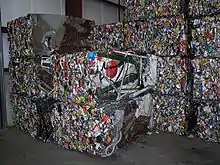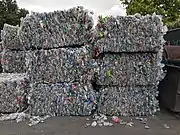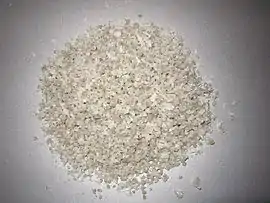Recycling by material
Recycling can be carried out on various raw materials. Recycling is an important part of creating more sustainable economies, reducing the cost and environmental impact of raw materials. Not all materials are easily recycled, and processing recyclable into the correct waste stream requires considerable energy. Some particular manufactured goods are not easily separated, unless specially process therefore have unique product-based recycling processes.
Asphalt
Asphalt concrete removed during road maintenance, resurfacing, and repair activities can be reclaimed and reused in new pavement mixtures, as an unbound aggregate base, or other civil engineering applications. Very little asphalt concrete — less than 1 percent, according to a survey by the Federal Highway Administration and the National Asphalt Pavement Association conducted annually since 2009 — is actually disposed of in landfills.[1] When asphalt pavement material is reclaimed for reuse, it is able to replace both virgin aggregates and virgin asphalt binder. Similarly, asphalt roof shingles can be recycled for use in new asphalt pavements.[2]
Concrete


Glass


.JPG.webp)
.jpg.webp)
Glass recycling is the processing of waste glass into usable products. Glass that is crushed or imploded and ready to be remelted is called cullet.[6] There are two types of cullet: internal and external. Internal cullet is composed of defective products detected and rejected by a quality control process during the industrial process of glass manufacturing, transition phases of product changes (such as thickness and color changes) and production offcuts. External cullet is waste glass that has been collected or reprocessed with the purpose of recycling. External cullet (which can be pre- or post-consumer) is classified as waste. The word "cullet", when used in the context of end-of-waste, will always refer to external cullet.
To be recycled, glass waste needs to be purified and cleaned of contamination. Then, depending on the end use and local processing capabilities, it might also have to be separated into different sizes and colours. Many recyclers collect different colors of glass separately since glass retains its color after recycling. The most common colours used for consumer containers are clear (flint) glass, green glass, and brown (amber) glass. Glass is ideal for recycling since none of the material is degraded by normal use.
Many collection points have separate bins for clear (flint), green and brown (amber). Glass re-processors intending to make new glass containers require separation by color, because glass tends to retain its color after recycling. If the recycled glass is not going to be made into more glass, or if the glass re-processor uses newer optical sorting equipment, separation by color at the collection point may not be required. Heat-resistant glass, such as Pyrex or borosilicate glass, must not be part of the glass recycling stream, because even a small piece of such material will alter the viscosity of the fluid in the furnace at remelt.
[7]Metals
Aluminium
Aluminium is one of the most efficient and widely recycled materials.[8][9] Aluminium is shredded and ground into small pieces or crushed into bales. These pieces or bales are melted in an aluminium smelter to produce molten aluminium. By this stage, the recycled aluminium is indistinguishable from virgin aluminium and further processing is identical for both. This process does not produce any change in the metal, so aluminium can be recycled indefinitely.
Recycling aluminium saves 95% of the energy cost of processing new aluminium.[10] This is because the temperature necessary for melting recycled, nearly pure, aluminium is 600 °C, while to extract mined aluminium from its ore requires 900 °C. To reach this higher temperature, much more energy is needed, leading to the high environmental benefits of aluminium recycling. Americans throw away enough aluminium every year to rebuild their entire commercial air fleet. Also, the energy saved by recycling one aluminium can is enough to run a television for three hours.[11]
Copper
Like aluminium,[12] copper is recyclable without any loss of quality, both from raw state and from manufactured products.[13] In volume, copper is the third most recycled metal after iron and aluminium.[14] An estimated 80% of all copper ever mined is still in use today.[15] According to the International Resource Panel's Metal Stocks in Society report, the global per capita stock of copper in use in society is 35–55 kg. Much of this is in more-developed countries (140–300 kg per capita) rather than less-developed countries (30–40 kg per capita).
The process of recycling copper is roughly the same as is used to extract copper but requires fewer steps. High-purity scrap copper is melted in a furnace and then reduced and cast into billets and ingots; lower-purity scrap is refined by electroplating in a bath of sulfuric acid.[16]Iron and steel

Iron and steel are the world's most recycled materials, and among the easiest materials to reprocess, as they can be separated magnetically from the waste stream. Recycling is via a steelworks: scrap is either remelted in an electric arc furnace (90-100% scrap), or used as part of the charge in a Basic Oxygen Furnace (around 25% scrap).[17] Any grade of steel can be recycled to top quality new metal, with no 'downgrading' from prime to lower quality materials as steel is recycled repeatedly. 42% of crude steel produced is recycled material.[18]
Other metals
For information about recycling other, less common metals, refer to:
- Bismuth recycling
- Lead recycling
Plastic
- Sorting plastic waste at a single-stream recycling centre
- Baled colour-sorted used bottles
- Recovered HDPE ready for recycling
- A watering can made from recycled bottles
Plastic recycling is the reprocessing of plastic waste into new products.[19][20][21] When performed correctly, this can reduce dependence on landfill, conserve resources and protect the environment from plastic pollution and greenhouse gas emissions.[22][23] Although recycling rates are increasing, they lag behind those of other recoverable materials, such as aluminium, glass and paper. The global recycling rate in 2015 was 9%, while 12% was incinerated and the remaining 79% disposed of to landfill or to the environment including the sea.[24] Since the beginning of plastic production in the 20th century, until 2015, the world has produced some 6.3 billion tonnes of plastic waste, only 9% of which has been recycled, and only ~1% has been recycled more than once.[24]
Recycling is necessary because almost all plastic is non-biodegradable and thus builds-up in the environment,[25][26] where it can cause harm. For example, approximately 8 million tons of waste plastic enter the Earth's oceans every year, causing damage to the aquatic ecosystem and forming large ocean garbage patches.[27]
Presently, almost all recycling is performed by remelting and reforming used plastic into new items; so-called mechanical recycling. This can cause polymer degradation at a chemical level, and also requires that waste be sorted by both colour and polymer type before being reprocessed, which is complicated and expensive. Failures in this can lead to material with inconsistent properties, rendering it unappealing to industry.[28] In an alternative approach known as feedstock recycling, waste plastic is converted back into its starting chemicals, which can then be reprocessed back into fresh plastic. This offers the hope of greater recycling but suffers from higher energy and capital costs. Waste plastic can also be burnt in place of fossil fuels as part of energy recovery. This is a controversial practice, but is nonetheless performed on a large scale. In some countries, it is the dominant form of plastic waste disposal, particularly where landfill diversion policies are in place.
Plastic recycling sits quite low in the waste hierarchy as a means of reducing plastic waste. It has been advocated since the early 1970s,[29] but due to severe economic and technical challenges, did not impact plastic waste to any significant extent until the late 1980s. The plastics industry has been criticised for lobbying for the expansion of recycling programs, even while industry research showed that most plastic could not be economically recycled and simultaneously increasing the amount of virgin plastic, or plastic that has not been recycled, being produced.[30][31]Timber

Recycling timber has become popular due to its image as an environmentally friendly product, with consumers commonly believing that by purchasing recycled wood the demand for green timber will fall and ultimately benefit the environment. Greenpeace also view recycled timber as an environmentally friendly product, citing it as the most preferable timber source on their website. The arrival of recycled timber as a construction product has been important in both raising industry and consumer awareness towards deforestation and promoting timber mills to adopt more environmentally friendly practices.
See also
- Index of recycling topics
References
- Williams, Brett A.; Willis, J. Richard; Ross, T. Carter (17 September 2019). IS 138: Asphalt Pavement Industry Survey on Recycled Materials and Warm-Mix Asphalt Usage — 2018 (PDF). Greenbelt, Maryland: National Asphalt Pavement Association. Archived (PDF) from the original on 2019-09-18. Retrieved 2019-07-18.
- "Economics and Markets for Recycling Asphalt Shingles". ShingleRecycling.org. Construction & Demolition Recycling Association. Retrieved January 14, 2020.
- "Home". ConcreteRecycling.org. Archived from the original on 2010-04-12. Retrieved 2010-04-05.
- "Urbanite - Reusing Old Concrete - The Concrete Network". ConcreteNetwork.com. Retrieved 2020-05-24.
- "Urbanite Construction". www.ecodesignarchitects.co.za. Retrieved 2020-05-24.
- "Glass, Common Wastes & Materials". US EPA. Retrieved 22 April 2012.
- "First in glass: 10 homegoods for Recycle Glass Month". MNN – Mother Nature Network.
- DRLP Fact Sheets
- Environmental Protection Agency Frequently Asked Questions about Recycling and Waste Management
- "The price of virtue". The Economist. June 7, 2007.
- "Recycling metals - aluminium and steel". Archived from the original on 2007-10-16. Retrieved 2007-11-01.
- Burton, Julie McCulloch (2015). Pen to Paper: Making Fun of Life. iUniverse. ISBN 978-1-4917-5394-1.
- Bahadir, Ali Mufit; Duca, Gheorghe (2009). The Role of Ecological Chemistry in Pollution Research and Sustainable Development. Springer. ISBN 978-90-481-2903-4.
- Green, Dan (2016). The Periodic Table in Minutes. Quercus. ISBN 978-1-68144-329-4.
- "International Copper Association". Archived from the original on 5 March 2012. Retrieved 22 July 2009.
- "Overview of Recycled Copper" Copper.org. (25 August 2010). Retrieved on 8 November 2011.
- "Sustainable Development and Steel, Canadian Institute of Steel Construction". Retrieved 2006-11-16.
- "Sustainable indicators 2014.pdf - World Steel Association" (PDF). Retrieved 2015-01-06.
- Al-Salem, S.M.; Lettieri, P.; Baeyens, J. (October 2009). "Recycling and recovery routes of plastic solid waste (PSW): A review". Waste Management. 29 (10): 2625–2643. doi:10.1016/j.wasman.2009.06.004. PMID 19577459.
- Ignatyev, I.A.; Thielemans, W.; Beke, B. Vander (2014). "Recycling of Polymers: A Review". ChemSusChem. 7 (6): 1579–1593. doi:10.1002/cssc.201300898. PMID 24811748.
- Lazarevic, David; Aoustin, Emmanuelle; Buclet, Nicolas; Brandt, Nils (December 2010). "Plastic waste management in the context of a European recycling society: Comparing results and uncertainties in a life cycle perspective". Resources, Conservation and Recycling. 55 (2): 246–259. doi:10.1016/j.resconrec.2010.09.014.
- Hopewell, Jefferson; Dvorak, Robert; Kosior, Edward (27 July 2009). "Plastics recycling: challenges and opportunities". Philosophical Transactions of the Royal Society B: Biological Sciences. 364 (1526): 2115–2126. doi:10.1098/rstb.2008.0311. PMC 2873020. PMID 19528059.
- Lange, Jean-Paul (12 November 2021). "Managing Plastic Waste─Sorting, Recycling, Disposal, and Product Redesign". ACS Sustainable Chemistry & Engineering. 9 (47): 15722–15738. doi:10.1021/acssuschemeng.1c05013.
- Geyer, Roland; Jambeck, Jenna R.; Law, Kara Lavender (July 2017). "Production, use, and fate of all plastics ever made". Science Advances. 3 (7): e1700782. Bibcode:2017SciA....3E0782G. doi:10.1126/sciadv.1700782. PMC 5517107. PMID 28776036.
- Andrady, Anthony L. (February 1994). "Assessment of Environmental Biodegradation of Synthetic Polymers". Journal of Macromolecular Science, Part C: Polymer Reviews. 34 (1): 25–76. doi:10.1080/15321799408009632.
- Ahmed, Temoor; Shahid, Muhammad; Azeem, Farrukh; Rasul, Ijaz; Shah, Asad Ali; Noman, Muhammad; Hameed, Amir; Manzoor, Natasha; Manzoor, Irfan; Muhammad, Sher (March 2018). "Biodegradation of plastics: current scenario and future prospects for environmental safety". Environmental Science and Pollution Research. 25 (8): 7287–7298. doi:10.1007/s11356-018-1234-9. PMID 29332271. S2CID 3962436.
- Jambeck, Jenna, Science 13 February 2015: Vol. 347 no. 6223; et al. (2015). "Plastic waste inputs from land into the ocean". Science. 347 (6223): 768–771. Bibcode:2015Sci...347..768J. doi:10.1126/science.1260352. PMID 25678662. S2CID 206562155.
- "Communication from the Commission to the European Parliament, the Council, the European Economic and Social Committee and the Committee of the Regions – A European Strategy for Plastics in a Circular Economy". eur-lex.europa.eu.
- Huffman, George L.; Keller, Daniel J. (1973). "The Plastics Issue". Polymers and Ecological Problems: 155–167. doi:10.1007/978-1-4684-0871-3_10. ISBN 978-1-4684-0873-7.
- National Public Radio, 12 September 2020 "How Big Oil Misled The Public Into Believing Plastic Would Be Recycled"
- PBS, Frontline, 31 March 2020, "Plastics Industry Insiders Reveal the Truth About Recycling"
.jpg.webp)

_01.jpg.webp)

